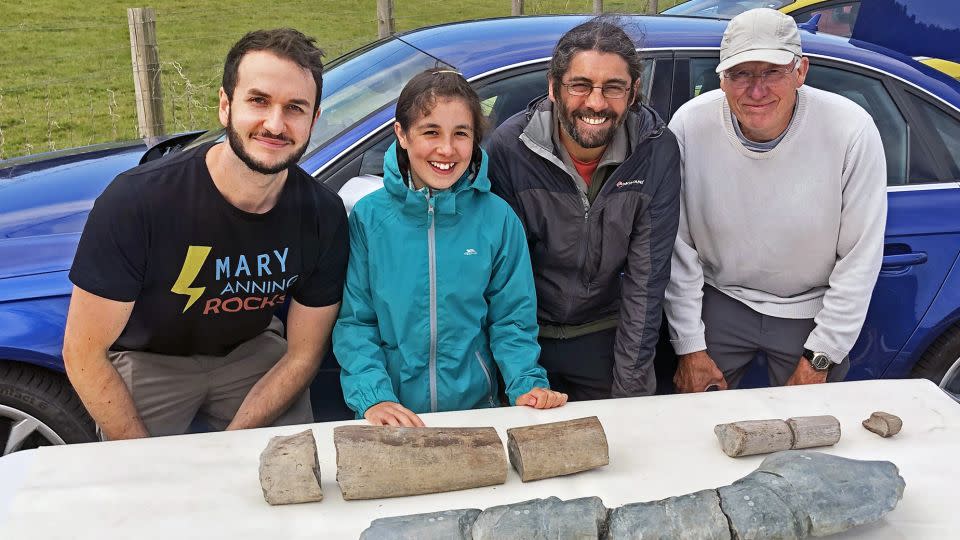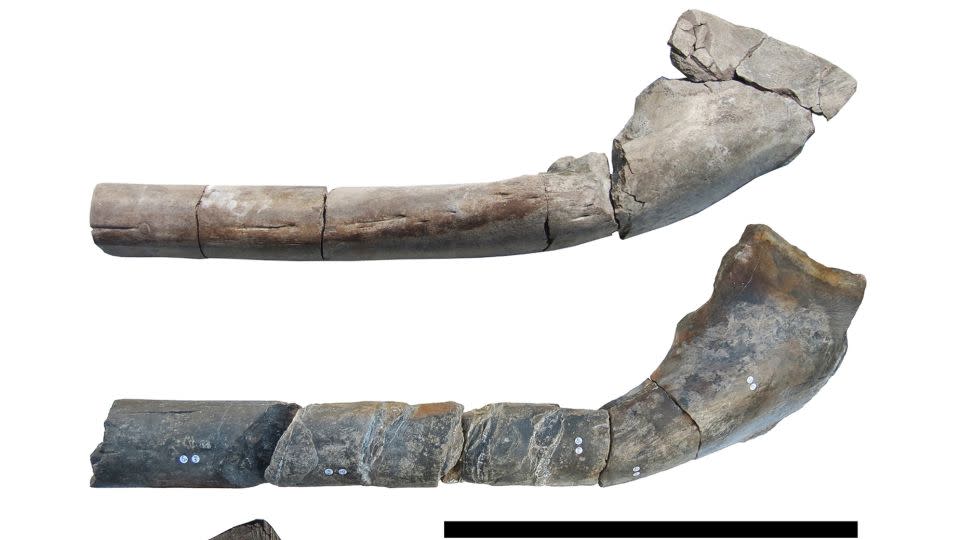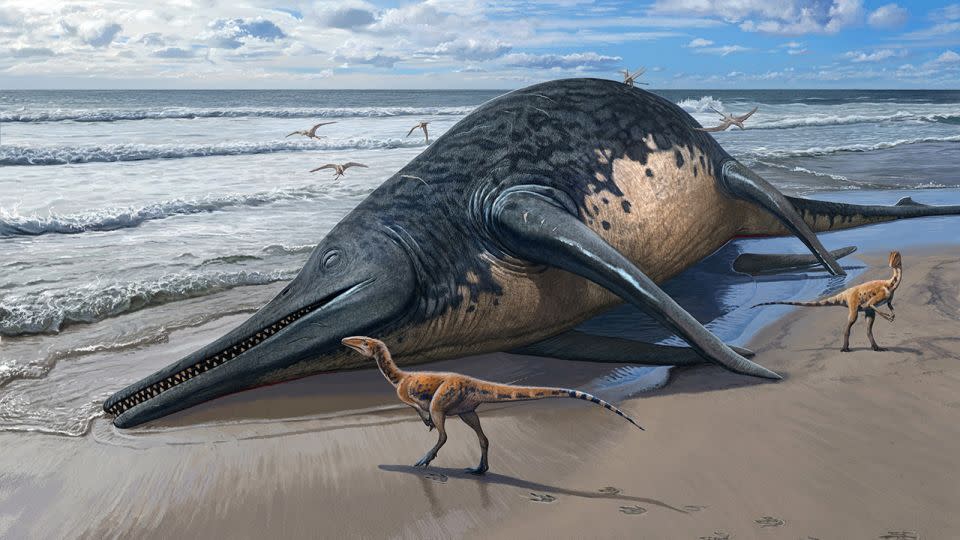11-year-old’s beach find was likely largest known marine reptile to swim Earth’s oceans, scientists say
Sign up for CNN’s Wonder Theory science newsletter. Explore the universe with news on fascinating discoveries, scientific advancements and more.
A massive jawbone found by a father-daughter fossil-collecting duo on a beach in Somerset along the English coast belonged to a newfound species that’s likely the largest known marine reptile to swim in Earth’s oceans.
Scientists consider the blue whale, which grows up to 110 feet (33.5 meters) long, to be the largest known animal ever to exist on the planet. But it’s possible that the 202 million-year-old reptile, known as an ichthyosaur or “fish lizard,” may have rivaled it in size.
The ichthyosaur’s jawbone, or surangular, was a long, curved bone at the top of the lower jaw just behind the teeth, and it measured more than 6.5 feet (2 meters) long. Researchers believe the creature, named Ichthyotitan severnensis, or “giant fish lizard of the Severn” in Latin, was more than 82 feet (25 meters) long, or the length of two city buses.
Justin and Ruby Reynolds, who live in Braunton, England, recovered the first pieces of the jawbone in May 2020 as they looked for fossils on the beach at Blue Anchor, Somerset. Ruby, 11 at the time, spotted the first chunk of bone, and then she and her dad found additional pieces together.
The remarkable find could shed more light on the prehistoric giant’s role in evolutionary history and the ocean ecosystem it called home, according to Marcello Perillo, a graduate student of evolutionary paleobiology at the University of Bonn in Germany. He is a coauthor of a new report describing the discovery that appeared Wednesday in the journal PLOS One.

Uncovering an unknown ichthyosaur
Encouraged at the thought that the fossil find could be significant, the Reynoldses reached out to Dr. Dean Lomax, a paleontologist at the University of Manchester and 1851 Research Fellow at the University of Bristol in the United Kingdom. An ichthyosaur expert, Lomax has named several species new to science in recent years.
Intrigued by the fossil, Lomax contacted fossil collector Paul de la Salle, who had found a giant ichthyosaur jawbone that looked remarkably similar in May 2016. De la Salle discovered the first jawbone about 6.2 miles (10 kilometers) away from Devon along the coast at Lilstock.
Lomax, who served as lead author of the new report, and coauthor de la Salle had studied the earlier find together and coauthored an April 2018 paper on the discovery, suspecting it might belong to a previously unknown ichthyosaur species. But the researchers needed additional evidence, and a second, nearly identical jawbone presented an opportunity to potentially confirm a new species.
“To think that my discovery in 2016 would spark so much interest in these enormous creatures fills me with joy,” de la Salle said. “When I found the first jawbone, I knew it was something special. To have a second that confirms our findings is incredible. I am overjoyed.”
Together, the Reynoldses, Lomax, de la Salle and others returned to Blue Anchor to search for additional fragments. The team recovered other pieces that fit together perfectly, like completing a puzzle.
“When Ruby and I found the first two pieces we were very excited as we realised that this was something important and unusual,” Justin Reynolds said in a statement. “When I found the back part of the jaw, I was thrilled because that is one of the defining parts of Paul’s earlier discovery.”
The researchers reassembled the jawbone by October 2022.
“I was amazed by the find,” Lomax said in a statement. “In 2018, my team (including Paul de la Salle) studied and described Paul’s giant jawbone and we had hoped that one day another would come to light. This new specimen is more complete, better preserved, and shows that we now have two of these giant bones — called a surangular — that have a unique shape and structure. I became very excited, to say the least.”
Piecing together a giant ichthyosaur
The bones date back to the end of the Triassic Period, during a time known as the Rhaetian when ichthyosaurs swam in the oceans and dinosaurs reigned on land.
The newly discovered jawbone is a better-quality specimen than the first, showcasing the features of the creature’s surangular that makes it distinct from other species, Lomax said.
The jawbones of severnensis date back roughly 13 million years after giant icthyosaur fossils belonging to different species that were previously found in Canada and China.
Ichthyosaurs, which slightly resembled modern dolphins, first appeared about 250 million years ago. Over time, some of them evolved to have larger body sizes, and by 202 million years ago, ocean titans such as severnensis were likely the largest marine reptiles.
But scientists believe that the giant ichthyosaurs disappeared during an ocean acidification event that occurred around 200 million years ago, and surviving ichthyosaurs never grew to such gargantuan sizes again before vanishing 94 million years ago.
The researchers stressed that further evidence is needed to confirm the exact size of severnensis, and they remain hopeful that a complete skull or skeleton may be discovered in the future, Lomax said.
Coauthor Perillo of the University of Bonn studied the histology, or microscopic anatomy, of the ichthyosaur bones and discovered that the reptile was likely still growing at the time of its death, meaning an adult severnensis may have been larger than a blue whale.

Histology can reveal the hidden biological information in fossilized bones, revealing how individual animals developed and adapted to specialized lifestyles, he said. For example, some ichthyosaurs had bones that helped them dive deep or live in shallow waters.
“Through the histology we can also understand how fast and for how long they grew; in the case of (the ichthyosaur) we could not see convincing signs indicating a stoppage of growth,” Perillo said. “This supports the idea that, had the animal not died, it likely would have kept getting larger, over its estimated 25 meters. So much about these giants is still shrouded by mystery, but one fossil at a time we will be able to unravel their secret.”
Uncovering the history of marine reptiles is crucial to understanding ancient ocean ecosystems because the creatures filled various niches and shaped ocean food chains, Perillo said, creating competition and a “never-ending spiral of evolution.”
“From them we can understand how evolutionary laws shaped life, what led life to be what it is now,” he said. “We can understand how changes in the environment recoil on ecological communities and predict future ecological developments in our current environment.”
The future of paleontology
Paleontologist Mary Anning and her older brother, Joseph, discovered the first known ichthyosaur fossils in 1811 and 1812, decades before the word dinosaur was even part of our lexicon. Since then, fossils belonging to more than 100 species of ichthyosaurs have been identified around the world.

The discovery made by the Reynoldses and de la Salle will soon be displayed at the Bristol Museum and Art Gallery in the UK.
“It was so cool to discover part of this gigantic ichthyosaur. I am very proud to have played a part in a scientific discovery like this,” Ruby Reynolds said in a statement.
Lomax said he has enjoyed working with fossil collectors in recent years because he believes paleontology is a scientific field in which anyone can make a significant contribution.
“For Ruby Reynolds, not only did she find this important fossil but also helped to name a type of gigantic prehistoric reptile,” Lomax said in an email. “There are probably not many 15-year-olds who can say that! A Mary Anning in the making, perhaps. But, whether or not Ruby goes down the path of palaeontology or science, the important thing is that she and Justin and Paul have contributed immensely to palaeontology and our understanding of the ancient world.”
For more CNN news and newsletters create an account at CNN.com
